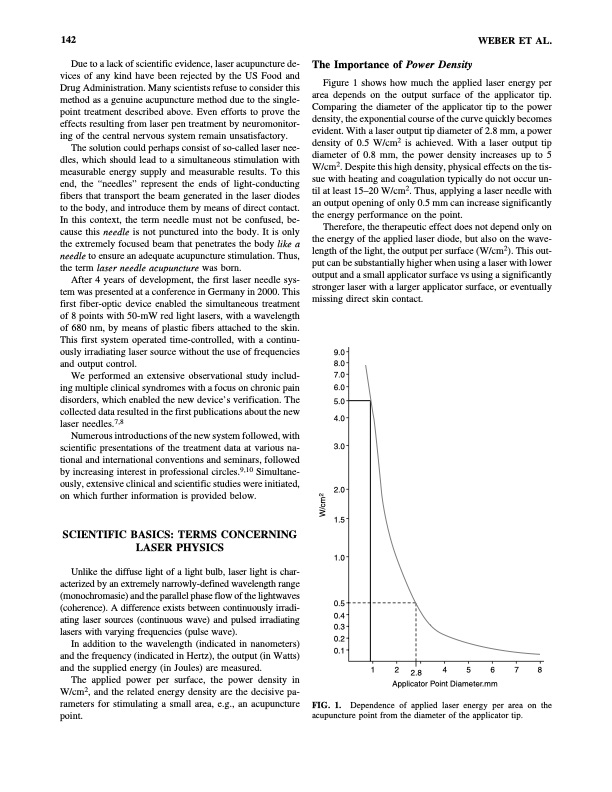
PDF Publication Title:
Text from PDF Page: 002
142 WEBER ET AL. Due to a lack of scientific evidence, laser acupuncture de- vices of any kind have been rejected by the US Food and Drug Administration. Many scientists refuse to consider this method as a genuine acupuncture method due to the single- point treatment described above. Even efforts to prove the effects resulting from laser pen treatment by neuromonitor- ing of the central nervous system remain unsatisfactory. The solution could perhaps consist of so-called laser nee- dles, which should lead to a simultaneous stimulation with measurable energy supply and measurable results. To this end, the “needles” represent the ends of light-conducting fibers that transport the beam generated in the laser diodes to the body, and introduce them by means of direct contact. In this context, the term needle must not be confused, be- cause this needle is not punctured into the body. It is only the extremely focused beam that penetrates the body like a needle to ensure an adequate acupuncture stimulation. Thus, the term laser needle acupuncture was born. After 4 years of development, the first laser needle sys- tem was presented at a conference in Germany in 2000. This first fiber-optic device enabled the simultaneous treatment of 8 points with 50-mW red light lasers, with a wavelength of 680 nm, by means of plastic fibers attached to the skin. This first system operated time-controlled, with a continu- ously irradiating laser source without the use of frequencies and output control. We performed an extensive observational study includ- ing multiple clinical syndromes with a focus on chronic pain disorders, which enabled the new device’s verification. The collected data resulted in the first publications about the new laser needles.7,8 Numerous introductions of the new system followed, with scientific presentations of the treatment data at various na- tional and international conventions and seminars, followed by increasing interest in professional circles.9,10 Simultane- ously, extensive clinical and scientific studies were initiated, on which further information is provided below. SCIENTIFIC BASICS: TERMS CONCERNING LASER PHYSICS Unlike the diffuse light of a light bulb, laser light is char- acterized by an extremely narrowly-defined wavelength range (monochromasie) and the parallel phase flow of the lightwaves (coherence). A difference exists between continuously irradi- ating laser sources (continuous wave) and pulsed irradiating lasers with varying frequencies (pulse wave). In addition to the wavelength (indicated in nanometers) and the frequency (indicated in Hertz), the output (in Watts) and the supplied energy (in Joules) are measured. The applied power per surface, the power density in W/cm2, and the related energy density are the decisive pa- rameters for stimulating a small area, e.g., an acupuncture point. The Importance of Power Density Figure 1 shows how much the applied laser energy per area depends on the output surface of the applicator tip. Comparing the diameter of the applicator tip to the power density, the exponential course of the curve quickly becomes evident. With a laser output tip diameter of 2.8 mm, a power density of 0.5 W/cm2 is achieved. With a laser output tip diameter of 0.8 mm, the power density increases up to 5 W/cm2. Despite this high density, physical effects on the tis- sue with heating and coagulation typically do not occur un- til at least 15–20 W/cm2. Thus, applying a laser needle with an output opening of only 0.5 mm can increase significantly the energy performance on the point. Therefore, the therapeutic effect does not depend only on the energy of the applied laser diode, but also on the wave- length of the light, the output per surface (W/cm2). This out- put can be substantially higher when using a laser with lower output and a small applicator surface vs using a significantly stronger laser with a larger applicator surface, or eventually missing direct skin contact. 9.0 8.0 7.0 6.0 5.0 4.0 3.0 2.0 1.5 1.0 0.5 0.4 0.3 0.2 0.1 1 2 2.8 4 5 6 7 8 Applicator Point Diameter.mm FIG. 1. Dependence of applied laser energy per area on the acupuncture point from the diameter of the applicator tip. W/cm2PDF Image | Needles of Light: A New Therapeutic Approach

PDF Search Title:
Needles of Light: A New Therapeutic ApproachOriginal File Name Searched:
Medical_Acupuncture-_Needles_of_Light_-_A_New_Therapeutic_Approach.pdfDIY PDF Search: Google It | Yahoo | Bing
Cruise Ship Reviews | Luxury Resort | Jet | Yacht | and Travel Tech More Info
Cruising Review Topics and Articles More Info
Software based on Filemaker for the travel industry More Info
The Burgenstock Resort: Reviews on CruisingReview website... More Info
Resort Reviews: World Class resorts... More Info
The Riffelalp Resort: Reviews on CruisingReview website... More Info
| CONTACT TEL: 608-238-6001 Email: greg@cruisingreview.com | RSS | AMP |